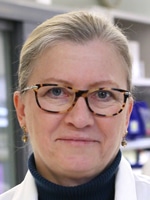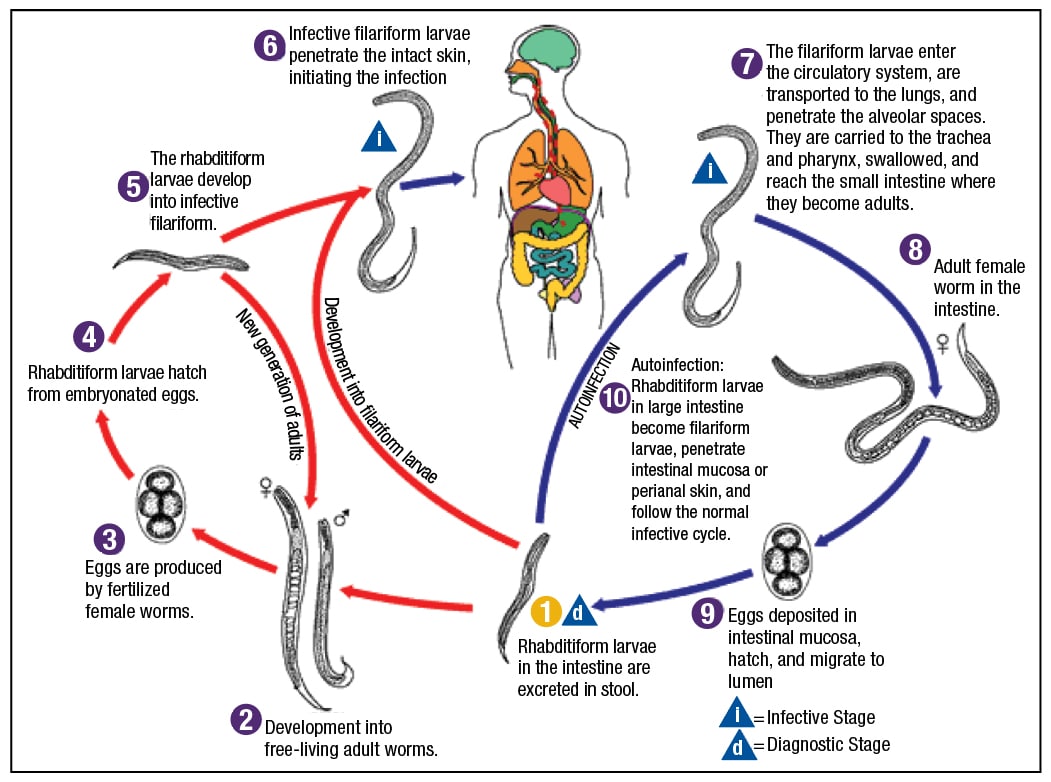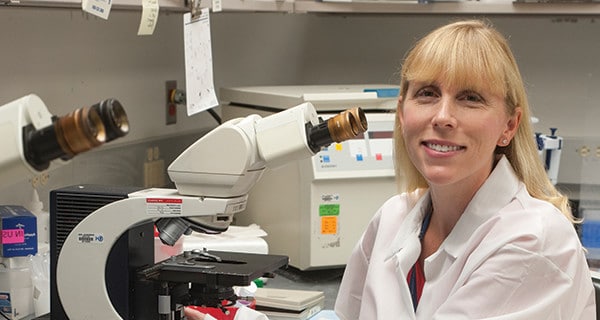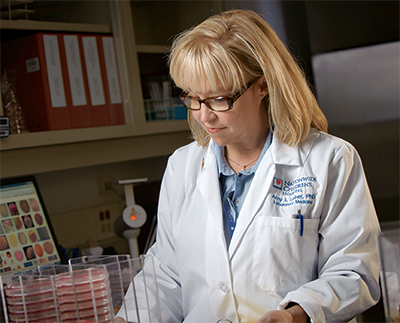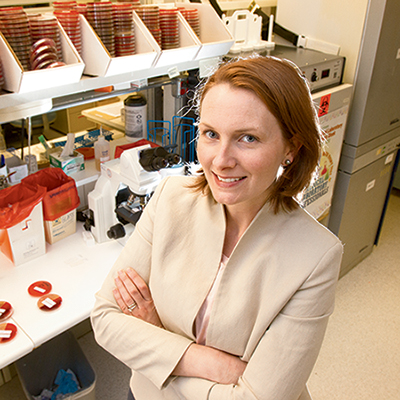October 2023—A CAP accreditation program requirement that microbiology laboratories use current antimicrobial susceptibility testing breakpoints, which was added to the checklist in 2021, will go into effect Jan. 1, 2024.
Read More »Lab’s steps to fewer contaminated urine cultures
September 2023—A casual comment made in a routine exchange in an Avera McKennan Hospital laboratory sparked a five-year campaign to bring down the urine culture contamination rate. “I feel like all I do is report contaminated cultures,” a microbiology technologist said in 2016.
Read More »In search for Candida auris, labs all in
June 2023—A bad-news, good-news, bad-news, good-news bass line thrums through the ongoing story of Candida auris as it continues to spread in the United States. Initially identified in Japan, in 2009, in an ear specimen—hence the auris—the yeast was first reported in the United States in 2016. Like certain other pathogens, C. auris’ domestic presence appeared to be linked to travel-related cases, then quickly spread, first to the metropolitan regions of Chicago and New York City and now to more than half the states. That’s worrisome. Yet the spread hasn’t been unbridled. Early fears that it would sweep indiscriminately through all patient populations have not been realized. “It’s not as virulent as albicans,” says Sixto M. Leal Jr., MD, PhD, director of the clinical microbiology laboratory and of the fungal reference laboratory, University of Alabama at Birmingham, and a member of the CAP Microbiology Committee. “It’s about as virulent as Candida glabrata. It’s not too much of a significant threat if you’re healthy.”
Lyme algorithms: stick to standard, move to modified?
June 2023—For Lyme disease testing, immunoblots became optional in 2019 when the FDA cleared enzyme immunoassays for use as part of a modified two-tiered testing algorithm. “It was a historic event in the world of Lyme diagnostics,” says Elitza Theel, PhD, D(ABMM).
Putting in place a molecular panel for pneumonia
March 2023—When it comes to molecular syndromic panels for pneumonia, there’s both upside and downside, says Neil W. Anderson, MD, D(ABMM), associate professor, Department of Pathology and Laboratory Medicine, Washington University School of Medicine in St. Louis.
Read More »For blood cultures, a lab’s new system and incubation time
January 2023—For the central microbiology laboratory serving Barnes-Jewish and four other hospitals in the St. Louis area, validating and implementing a new blood culture system and moving to a shorter incubation time came at a perfect time: right before the pandemic.
Read More »The who, what, and when of respiratory virus testing
November 2022—In mid-October, flu was picking up, with high levels of activity in Texas, Georgia, the District of Columbia, South Carolina, Tennessee, and New York. Elsewhere, it was still on the lower side, with less known about what was to come but plans in place. And questions, too, about laboratory testing as it relates to SARS-CoV-2, “which is going to be a challenge,” says David Peaper, MD, PhD, D(ABMM), a member of the CAP Microbiology Committee.
Read More »The art and science of positive blood cultures
October 2022—It might be possible to tot up, using only the number of toes on an ordinary foot, how many labs are feeling full of vim and vigor these days, open to concepts like creative destruction and get those creative juices flowing and have fun with it—slogans once easily uttered but now tiring to enact. Nevertheless, Margie Morgan, PhD, D(ABMM), would like her colleagues to at least consider the possibility of inspiration in the microbiology laboratory. In particular, Dr. Morgan, medical director of microbiology and professor of pathology and laboratory medicine, Cedars-Sinai Medical Center, Los Angeles, has some thoughts about using a new automated system to facilitate rapid microbial identification from positive blood cultures. The Arc system, from Accelerate Diagnostics, is composed of the Arc module and blood culture kit and concentrates organisms recovered in positive blood cultures for direct testing on MALDI-TOF mass spectrometry. Dr. Morgan and colleagues have been using the system since February.
Read More »Infectious diseases of the gut
August 2022—The atypia in Epstein-Barr virus-positive mucocutaneous ulcers can mimic diffuse large B-cell lymphoma or classical Hodgkin lymphoma, a diagnostic pitfall that can result in overtreatment. And esophageal ulcers in immunocompromised patients should trigger cytomegalovirus immunohistochemistry in addition to GMS and herpes simplex virus-1 and -2 stains.
What’s bugging the gut? A team approach
July 2022—Gut pathogens, their histologic features, and a GI pathology and microbiology team approach to diagnosis were the focus of a CAP21 session, “What’s Bugging the Gut?” Maryam Zenali, MD, Alina Iuga, MD, and Christina Wojewoda, MD, presented a series of cases and highlighted the features, the differential diagnoses, and the integrated workups. Three of their cases follow here, with others to be reported in an upcoming issue.
Read More »Leaving behind outdated AST breakpoints
May 2022—Among the countless interruptions COVID-19 has inflicted on the medical community, one of the most obvious has been conversational. In the face of a global pandemic, other topics can seem unworthy of discussion. But as some post-pandemic normalcy creeps back in, so does the focus on topics of equal, if less dramatic, importance.
First IQCP template set up for molecular tests
April 2022—Drawing on five years of experience and laboratory feedback, a collaborative team has revised the microbiology IQCP templates and created the first template for the quality control of a commercial cartridge-based molecular test system.
Read More »AMP case report: Rhinoscleroma in Southern California—diagnosis made by multidisciplinary investigation
January 2022—A 33-year-old male with progressive hoarseness and shortness of breath was given a purported diagnosis of laryngeal papillomatosis and referred to our institution in November 2020 for a higher level of care. On presentation, the patient reported no recent upper respiratory infection-like systemic symptoms but had cough, nasal congestion, throat discomfort, dysphonia, and worsening dyspnea.
Read More »AST and safety at core of microbiology checklist changes
October 2021—By Jan. 1, 2024, laboratories must use current breakpoints to interpret antimicrobial minimum inhibitory concentration and disk diffusion test results, according to a new requirement in the latest edition of the CAP Accreditation Programs microbiology checklist, released Sept. 22.
Read More »Resistance targets: blood culture ID panel pitfalls
May 2021—Most of the time, bloodstream infection antimicrobial resistance results achieved with blood culture molecular ID panels will be accurate. When and why they might not be was the focus of an AMP 2020 virtual session. “I don’t want to lead anyone to believe that these are not good, accurate, and important types of tests,” Richard E. Davis, PhD, D(ABMM), MLS(ASCP)CM, said of the panels.
Read More »‘Know your panel’: Blood culture ID cautions
April 2021—The interpretive challenges of blood culture identification panels were the focus of an AMP2020 virtual presentation on false-positives and false-negatives and their sources and solutions.
Read More »Problems, solutions at core of UTI, C. diff modules
April 2021—Urinary tract infections and Clostridioides (Clostridium) difficile testing are the topics of two of the modules released recently in the CAP Test Ordering Program. The Laboratory Workup for Urinary Tract Infections module became available online in January, and C. difficile Testing in October 2020 (www.cap.org/member-resources/test-ordering-program). The program is free to CAP members.
Read More »Rapid ID from positive blood culture: Labs tally gains
March 2021—Fresh from its Dec. 27, 2020 FDA clearance, the Bruker MALDI Sepsityper Kit US IVD promises to provide microbiology laboratories with a universal, rapid sepsis identification solution. With the Bruker MALDI Biotyper platform’s reference library covering 491 organisms, the Sepsityper’s ability to identify pathogens directly from positive blood cultures in suspected bacterial or fungal sepsis cases delivers an “order of magnitude increase” in the number of microorganisms that can be identified through PCR detection, said Wolfgang Pusch, Bruker Daltonics executive vice president of microbiology and diagnostics, in a company statement.
Read More »Fewer urine cultures — series of changes add up
November 2020—Five years after putting in place a urine reflex algorithm at Barnes-Jewish Hospital in St. Louis, and many tweaks later, Melanie Yarbrough, PhD, D(ABMM), D(ABCC), has tips to share on how to increase the odds for success in reducing the number of urine cultures.
Read More »Targeting microbiology lab efficiency with AI
August 2020—Bringing an automated culture plate reading system into the Hennepin County Medical Center microbiology laboratory was never a question of if but when. “We need artificial intelligence to help us with active decision-making processes in the lab,” says Glen Hansen, PhD.
Read More »Lab with Ebola experience: COVID more complicated
August 2020—If there’s one thing scarier to experience than COVID-19, it’s Ebola. Or so you might think. “Ebola was easier,” says Beverly Dickson, MD, medical director of the clinical laboratory at Texas Health Presbyterian Hospital Dallas.
Read More »Adapting test ordering to novel tick-borne disease rise
May 2020—When tick-borne infections are the topic of discussion, talk of Lyme disease, caused by Borrelia burgdorferi, has tended to predominate. But as the prevalence of tick-borne infections in the United States rises steadily and widens geographically, the number of novel pathogens carried by ticks has been climbing as well.
Read More »AST breakpoints: a case of not aging gracefully
April 2020—When Romney Humphries, PhD, D(ABMM), was section chief for clinical microbiology at UCLA Medical Center, it wasn’t unusual for her to take calls from worried clinicians who were concerned about patients who’d been transferred to the hospital for a higher level of care. The accompanying laboratory reports would indicate the presence of an isolate that was susceptible to a particular drug. But when Dr. Humphries’ lab did its own testing, the results were strikingly different: The isolate was drug resistant. When Dr. Humphries would call the first lab, the reason for the discrepancy became clear. “Sure enough, they were using old breakpoints,” says Dr. Humphries, who is now chief scientific officer, Accelerate Diagnostics, and professor of pathology, University of Arizona. Unlike Bordeaux, antimicrobial susceptibility test breakpoints do not age well. Over time, they might no longer be clinically useful, even as they continue to be used clinically. Dr. Humphries’ anecdote is, of course, just that—an anecdote.
Read More »C. auris: ‘The more we see, the more resistance’
March 2020—While developing into a global health emergency that has killed thousands, the outbreak of the SARS-CoV-2 coronavirus identified in China riveted the public and raised awareness of infectious diseases and their perils.
Read More »For molecular ID testing, micro lab or molecular lab?
March 2020—Where should molecular infectious disease testing be performed? That was the question at the center of a point-counterpoint session at last year’s AMP annual meeting.
Read More »New requirements for molecular micro waived testing
September 2019—Four new checklist requirements for waived molecular-based microbiology tests have been added to the CAP point-of-care testing, limited service laboratory, and immunology accreditation program checklists, as part of the 2019 checklist edition released this month.
Read More »Know them when you see them: parasites in tissue
February 2019—In one case, Dr. Ribes found herself intrigued by structures in a patient’s urine cytology specimen. A 36-year-old man from the Republic of Congo had developed dysuria, increased urinary frequency, and terminal hematuria. What they found in the Pap stain in cytology, she said, were large purple structures with the knob at the end.
Read More »Parasites in tissue: how to identify the structures
January 2019—Pathologists who aren’t microbiologists can provide a diagnosis of parasitic disease if they take into account parasite life cycles and tissue tropisms. Julie A. Ribes, MD, PhD, made that key point in cases she presented in her CAP18 session, “Update on Invasive Parasitic Infections for Surgical Pathologists.” Dr. Ribes added learning material to most of the cases, she said, but the cases come from parasites she has seen and known in her own professional life.
Read More »Microbiology’s shifting role in war on sepsis
August 2018—If you were casting about for the severest test of a laboratory’s capabilities, day in and day out, sepsis admissions at a pediatric hospital might fit the bill. At Children’s Hospital of Philadelphia, and at other hospitals, waging war on sepsis requires battles on multiple fronts and clinical pathways that rely on an agile and highly equipped microbiology laboratory. Three main categories of patients ensure there is no shortage of sepsis cases at CHOP, says Erin H. Graf, PhD, D(ABMM), director of the infectious disease diagnostics laboratory.
Read More »New contender speeds ID with susceptibility testing
May 2018—If a seismic shift were to happen in microbiology, the technology behind the Accelerate Pheno system and PhenoTest BC test kit, which won FDA approval last year as a rapid pathogen identification and antimicrobial susceptibility testing (AST) system for blood cultures, could well be the cause.
Read More »TLA in, volume up—micro labs take stock
May 2017—Rise of the Robots. Disruption. Humans Need Not Apply. “The Future of Work.” A flood of books and articles in the past several months make the argument that service industries in the U.S. hover on the brink of total automation and humans will have to figure out how to adapt. Forty-five years ago, when Michael R. Jacobs, MD, PhD, started in microbiology, people fantasized about microbiology reaching this stage.
Read More »One bug or prix fixe? Respiratory pathogen testers weigh in
February 2017—With the number of rapid, accurate molecular assays for respiratory pathogens growing, microbiology laboratories have more options than ever. They include, among others, Meridian Bioscience’s Illumigene assays for group A Streptococcus and pertussis and its newest assay, Mycoplasma Direct, as well as Alere’s assays for influenza A/B, respiratory syncytial virus, and Streptococcus on its i molecular platform. No longer are laboratories limited to inaccurate rapid antigen tests, weeks-long culture, or multi-pathogen panels.
Read More »FilmArray GI: findings from first months of clinical use
April 2016—Treating Clostridium difficile can be dreadfully difficult, even when a clinician doesn’t have to navigate ordering restrictions based on testing frequency. So when Julie A. Ribes, MD, PhD, director of clinical microbiology at UK HealthCare in Lexington, Ky., received a phone call last year from a clinician who asked for repeat C. difficile testing, she was more than sympathetic.
Read More »Cutting cultures: the move to all molecular in virology
March 2016—For laboratories performing virology testing, taking advantage of molecular testing’s superiority to traditional testing methods is a no-brainer. But leaders in the University of Michigan’s clinical microbiology laboratory have found that the push to go all molecular for virology testing must be tempered by attentiveness to clinician preferences and a collaborative approach that’s likelier to make the journey a success.
Read More »Urine preanalytics guideline effort highlights data need
February 2016—When it comes to recommended practices for preanalytic handling of urine specimens for the microbiology lab, Alice S. Weissfeld, PhD, D(ABMM), has a blunt and colorful take: “I call it ‘running our lab based on urban legend.’”
Read More »When to fire up large multiplex PCR?
January 2016—Multiplex PCR panel tests for viral and gastrointestinal pathogens as well as the rapid identification of bloodstream infections can detect more pathogens more quickly than traditional microbiology methods.The question that continues to bedevil is how to offer this newer breed of tests.
Read More »For infection control, PCR and culture compared
Plus, an in-house PCR test for HSV in CSF
January 2016—There is a reason why rigorous studies are done to prove even the seemingly apparent benefits of advanced techniques. Sometimes comparisons turn up unexpected findings, as demonstrated by two selected infectious disease abstracts about real-time PCR presented at the Nov. 5–7, 2015 meeting of the Association for Molecular Pathology. Even so, both abstracts show the value of PCR testing.
Read More »Full-court collaboration in transition to IQCP
September 2015—With the CLIA Individualized Quality Control Plan process geared to unseat the familiar Equivalent Quality Control process on Jan. 1, there seems to be wide agreement that microbiology laboratories will have the biggest adjustment to make to comply with CLIA QC requirements, despite the IQCP being voluntary.
Read More »Superbugs on scopes: how UCLA lab found the outbreak
August 2015—It sounds a bit like an Agatha Christie story: Two hospital patients, two lengthy stays, two adjacent but separate rooms. Patient A comes in with a Klebsiella pneumoniae carbapenemase-producing isolate. Patient B doesn’t . . . but within 30 days, he’s acquired it. How?
Read More »MALDI in microbiology: Set to stun?
May 2015—In the business world, the term “disruptive innovation” is hot. In product launches, business plans, and job resumes, it’s become a standard part of the pitch. Like the flux capacitor in the fictional DeLorean time machine, disruptive innovations vault a field past traditional barriers and obstacles, outstripping rival technologies.
Read More »Critical stressors in the microbiology lab: four Cs
April 2015—If you ask average patients what infectious diseases they worry about contracting during a hospital stay, Ebola may top the list, perhaps followed by MRSA and HIV. But ask clinical microbiologists what has been keeping them up at night lately, and those pathogens aren’t the ones they cite.
Read More »From the bench, a view of MALDI-TOF mass spec
February 2015—Melissa Jones, MT(ASCP), doesn’t mince words—not when it comes to MALDI-TOF MS. “It’s going to revolutionize the way you do microbiology in your laboratory, and you’re absolutely going to love it,” said Jones, who is a microbiology specialist for clinical microbiology and immunology at McLendon Clinical Laboratories at University of North Carolina Hospitals, Chapel Hill.
Read More »Microbiology automation: finding the right mix
April 2014—Talk to a few microbiology laboratories about why they feel the need to automate and you hear common themes: people, space, quality, and, most of all, time to detection. Microbiology may be late to join the bandwagon, but whether laboratories are making partial or full-scale moves to automate, they are dramatically making up for lost time, in all senses of the phrase. That’s because turnaround time savings are no longer measured in minutes. “Our goal is to be able to give some of these answers out in one to four hours rather than 24 hours, or much longer for some culture-based methods,” says Randall T. Hayden, MD, director of clinical and molecular microbiology at St. Jude Children’s Hospital in Memphis.
Read More »Labs weighing pros, cons of micro TLA
January 2014—Sleek specimen processing instruments, often with sophisticated robotics, are features of many larger microbiology laboratories, despite the longstanding belief that microbiology is too complex to automate. But total laboratory automation (TLA) has not yet gained a foothold in the U.S., even though there are several installations in microbiology laboratories in Europe. Could 2014 be the year that total microbiology laboratory automation comes into its own?
Read More »Results reporting in microbiology: What’s needed, what’s not?
November 2013—After the patient specimens have been collected and the tests have been performed, after the legwork is complete and the results are in hand, reporting clinical microbiology findings should in theory be the easy part—the final step before an effective treatment plan is formed. But as any seasoned clinical microbiologist knows, that couldn’t be further from the truth.
Read More »Adventures in culturing—five micro lab tales
October 2013—Culturing organisms is not always easy. Some microbes are fastidious. Others are below the limits of detection. And still others are just difficult to culture, for no discernible reason.
Read More »Checklists 2013: newborn screening and MALDI-TOF
August 2013—At CAP ’11, then president-elect Stanley Robboy, MD, sat at a table in a conference room. He didn’t know those seated with him but he and they started to chat. The conversation turned to Dr. Robboy’s goals for his upcoming presidential term, and a member from Saudi Arabia, Amal Saadallah, MD, PhD, proposed that newborn screening requirements be created for accreditation.
Read More »Microbiology QA, measure for measure
August 2013—In the May 20, 2013 issue of the New Yorker, Google co-founder Sergey Brin is quoted as saying of Internet security: “In big corporations people don’t understand what security people do, for the most part, and no one pays attention to them unless something goes wrong. Frankly, a lot of companies aren’t that interested in security.”
Read More »Triple play in lab’s MALDI-TOF efforts
January 2013—When James Musser, MD, PhD, and colleagues at Houston’s The Methodist Hospital submitted a study for publication this fall (to “one of the prestigious weeklies based in a northeastern part of the country,” says Dr. Musser), they were prepared to answer questions from reviewers.
Read More » CAP TODAY Pathology/Laboratory Medicine/Laboratory Management
CAP TODAY Pathology/Laboratory Medicine/Laboratory Management
